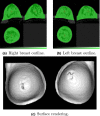Breast MRI segmentation for density estimation: Do different methods give the same results and how much do differences matter?
- PMID: 28477346
- PMCID: PMC5697622
- DOI: 10.1002/mp.12320
Breast MRI segmentation for density estimation: Do different methods give the same results and how much do differences matter?
Abstract
Purpose: To compare two methods of automatic breast segmentation with each other and with manual segmentation in a large subject cohort. To discuss the factors involved in selecting the most appropriate algorithm for automatic segmentation and, in particular, to investigate the appropriateness of overlap measures (e.g., Dice and Jaccard coefficients) as the primary determinant in algorithm selection.
Methods: Two methods of breast segmentation were applied to the task of calculating MRI breast density in 200 subjects drawn from the Avon Longitudinal Study of Parents and Children, a large cohort study with an MRI component. A semiautomated, bias-corrected, fuzzy C-means (BC-FCM) method was combined with morphological operations to segment the overall breast volume from in-phase Dixon images. The method makes use of novel, problem-specific insights. The resulting segmentation mask was then applied to the corresponding Dixon water and fat images, which were combined to give Dixon MRI density values. Contemporaneously acquired T1 - and T2 -weighted image datasets were analyzed using a novel and fully automated algorithm involving image filtering, landmark identification, and explicit location of the pectoral muscle boundary. Within the region found, fat-water discrimination was performed using an Expectation Maximization-Markov Random Field technique, yielding a second independent estimate of MRI density.
Results: Images are presented for two individual women, demonstrating how the difficulty of the problem is highly subject-specific. Dice and Jaccard coefficients comparing the semiautomated BC-FCM method, operating on Dixon source data, with expert manual segmentation are presented. The corresponding results for the method based on T1 - and T2 -weighted data are slightly lower in the individual cases shown, but scatter plots and interclass correlations for the cohort as a whole show that both methods do an excellent job in segmenting and classifying breast tissue.
Conclusions: Epidemiological results demonstrate that both methods of automated segmentation are suitable for the chosen application and that it is important to consider a range of factors when choosing a segmentation algorithm, rather than focus narrowly on a single metric such as the Dice coefficient.
Keywords: ALSPAC; MRI; breast cancer; mammographic density; segmentation.
© 2017 The Authors. Medical Physics published by Wiley Periodicals, Inc. on behalf of American Association of Physicists in Medicine.
Figures










Similar articles
-
Automated fibroglandular tissue segmentation and volumetric density estimation in breast MRI using an atlas-aided fuzzy C-means method.Med Phys. 2013 Dec;40(12):122302. doi: 10.1118/1.4829496. Med Phys. 2013. PMID: 24320533 Free PMC article.
-
Automatic outer and inner breast tissue segmentation using multi-parametric MRI images of breast tumor patients.PLoS One. 2018 Jan 10;13(1):e0190348. doi: 10.1371/journal.pone.0190348. eCollection 2018. PLoS One. 2018. PMID: 29320532 Free PMC article.
-
A new bias field correction method combining N3 and FCM for improved segmentation of breast density on MRI.Med Phys. 2011 Jan;38(1):5-14. doi: 10.1118/1.3519869. Med Phys. 2011. PMID: 21361169 Free PMC article.
-
An investigation of the effect of fat suppression and dimensionality on the accuracy of breast MRI segmentation using U-nets.Med Phys. 2019 Mar;46(3):1230-1244. doi: 10.1002/mp.13375. Epub 2019 Feb 4. Med Phys. 2019. PMID: 30609062
-
Automated breast segmentation of fat and water MR images using dynamic programming.Acad Radiol. 2015 Feb;22(2):139-48. doi: 10.1016/j.acra.2014.09.015. Acad Radiol. 2015. PMID: 25572926 Free PMC article.
Cited by
-
Automatic and fast segmentation of breast region-of-interest (ROI) and density in MRIs.Heliyon. 2018 Dec 17;4(12):e01042. doi: 10.1016/j.heliyon.2018.e01042. eCollection 2018 Dec. Heliyon. 2018. PMID: 30582055 Free PMC article.
-
Quantitative Measurement of Breast Density Using Personalized 3D-Printed Breast Model for Magnetic Resonance Imaging.Diagnostics (Basel). 2020 Oct 6;10(10):793. doi: 10.3390/diagnostics10100793. Diagnostics (Basel). 2020. PMID: 33036272 Free PMC article.
-
Quantitative Measurements of Breast Density Using Magnetic Resonance Imaging: A Systematic Review and Meta-Analysis.J Clin Med. 2019 May 24;8(5):745. doi: 10.3390/jcm8050745. J Clin Med. 2019. PMID: 31137728 Free PMC article. Review.
-
Automated Segmentation of Tissues Using CT and MRI: A Systematic Review.Acad Radiol. 2019 Dec;26(12):1695-1706. doi: 10.1016/j.acra.2019.07.006. Epub 2019 Aug 10. Acad Radiol. 2019. PMID: 31405724 Free PMC article.
-
Automatic breast tissue segmentation in MRIs with morphology snake and deep denoiser training via extended Stein's unbiased risk estimator.Health Inf Sci Syst. 2021 Apr 5;9(1):16. doi: 10.1007/s13755-021-00143-x. eCollection 2021 Dec. Health Inf Sci Syst. 2021. PMID: 33898019 Free PMC article.
References
-
- McCormack VA, Silva IDS. Breast density and parenchymal patterns as markers of breast cancer risk: a meta‐analysis. Cancer Epidemiol Biomarkers Prev. 2006;15:1159–1169. - PubMed
-
- Price ER, Keedy AW, Gidwaney R, Sickles EA, Joe BN. The potential impact of risk‐based screening mammography in women 40‐49 years old. Am J Roentgenol. 2015;205:1360–1364. - PubMed
-
- Ciatto S, Houssami N, Apruzzese A, et al. Categorizing breast mammographic density: intra‐ and interobserver reproducibility of bi‐rads density categories. Breast 2005;14:269–275. - PubMed
-
- Highnam R, Brady SM, Yaffe MJ, Karssemeijer N, Harvey J. Robust breast composition measurement ‐ volparatm In: Mart J, Oliver A, Freixenet J, Mart R, eds. Digital Mammography: 10th International Workshop, IWDM 2010, Girona, Catalonia, Spain, June 16–18, 2010. Proceedings. Berlin, Heidelberg: Springer Berlin Heidelberg; 2010: 342–349.
MeSH terms
Grants and funding
LinkOut - more resources
Full Text Sources
Other Literature Sources
Medical

